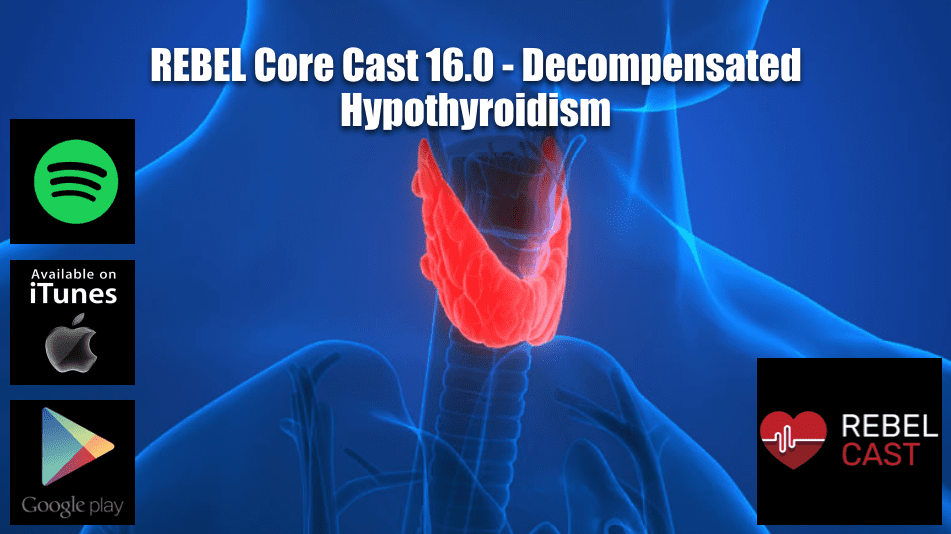
 Take Home Points
Take Home Points
- Myxedema coma is severe, decompensated hypothyroidism with a very high mortality.
- Classic features include: decreased mental status, hypothermia, hypotension, bradycardia, hyponatremia, hypoglycemia, and hypoventilation
- Work up includes looking for and treating precipitating causes, most commonly infection as well as serum levels of TSH, T4 and cortisol
- Treat for the possibility of adrenal insufficiency with stress dose steroids such as hydrocortisone 100 mg IV
- The exact means of thyroid replacement is controversial. Definitely given 100-500 mcg levothyroxine and discuss the simultaneous administration of T3 with your endocrine and ICU teams.
Shownotes
Patient presentation
Elderly patient presenting to the department from a nursing facility without any records. Patient was altered, hypotensive, bradycardic & hypothermic. Also noted to have hypoventilation and some gurgling respiratory sounds
The initial thought might be that this is a run of the mill septic patient and likely bradycardic because of being on some beta blocker. However don’t be so fast, we need to broaden the differential and think of a few more things.
Hypotension and bradycardia? What’s the differential for that? Think of myocardial infarction leading to cardiogenic shock, blood in the abdomen causing a vagal response, calcium channel blocker or beta blocker toxicity, clonidine toxicity and neurogenic shock.
The team started the sepsis protocol for the patient, however, it was noted they were severely hypothermic. Patients with sepsis can present with hypothermia typically in the 93-94F range but when core temperature is 90F and below without good explanation as to why its so low we should consider thyroid disorders.
Myxedema Coma
- Severe hypothyroidism leading to decreased mental status, hypothermia, and other symptoms related to slowing of function in multiple organs.
- Exceedingly high mortality rate of 30-60%
- Important to note patients deterioration of mental status because coma uncommon presentation
- Patients generally don’t show myxedema (nonpitting edema)
- Hypothyroidism 4x more common in women, 80% of cases of Myxedema occur in women.
- Generally occurs to older population, >60 years old.
- 90% of cases occur during the winter months
What incites Myxedema?
Can present with patient with longstanding undiagnosed hypothyroidism or if its poorly managed.
It can also present with patients that have a history of hypothyroidism that have incuccured an insult like sepsis, MI, cold exposure, surgery & even sedating medications like opiods.
Typical Presentation
Decreased mental status but can be subtle
HYPOeverything – hypotension, hypoglycemia, hyponatremia, hypoventilation, *hypocardia*, bradycardia but hypocardia sounded cooler.
Myxedema refers to puffiness of the hands and face, a thickened nose, swollen lips, and an enlarged tongue that are due to a non pitting edema with abnormal deposits of albumin and mucin
Why the Hypo findings?
- Hypoglycemia – may be caused by hypothyroidism alone or may be due to concurrent adrenal insufficiency due to autoimmune adrenal disease or hypothalamic-pituitary disease.
- Hyponatremia – could be due to impairment in free water excretion due to inappropriate excess vasopressin secretion or impaired renal function or also could be due to adrenal insufficiency.
- Hypoventilation – due primarily to central depression of the ventilatory drive with decreased responsiveness to hypoxia and hypercapnia.
- Hypotension – Decompensated hypothyroidism leads to bradycardia, decreased myocardial contractility, a low cardiac output, and hypotension.
Work up
These labs take some time to come back so diagnosis has to be made on clinical suspicion.
- TSH – variable levels. If high then primary hypothyroidism. If low, normal, or slightly high than central hypothyroidism.
- T4 – usually very low
- Cortisol
- Sepsis workup – Remember precipitating event can be infectious so do usual sepsis workup.
Treatment
- Steroids – 100mg Hydrocortisone IV for suspected adrenal insufficiency
-
Thyroid Hormone – Levothyroxine 100-150mcg
- Controversial topic, some experts also recommend adding T3 at 5-20mcg dose. Recommend obtaining Endocrine & ICU consult prior to administering.
- Fluids – Usually hypotensive so start with fluids
- Vasopressors – If volume depletion ruled out, start pressors.
- Remember to treat underlying cause of myxedema!
REBEL Core Cast 16.0 – Decompensated Hypothyroidism
Click here for Direct Download of Podcast
Resources:
- Kwaku MP and Burman KD. Myxedema coma. J Intensive Care Med. 2007 Jul-Aug;22(4):224-31. PMID: 17712058
- Ross, DR. Myxedema coma. UpToDate.
- Swadron, S. A New Look at Thyroid Emergencies Part I: Myxedema Coma. Emergency Physicians Monthly.
- Wall, CR. Myxedema coma: diagnosis and treatment. Am Fam Physician. 2000 Dec 1;62(11):2485-90. PMID 11130234
Shownotes Written By: Miguel Reyes, MD (Twitter: @miguel_reyesMD)
Post Peer Reviewed By: Salim R. Rezaie, MD (Twitter: @srrezaie)
The post REBEL Core Cast 16.0 – Decompensated Hypothyroidism appeared first on REBEL EM - Emergency Medicine Blog.
